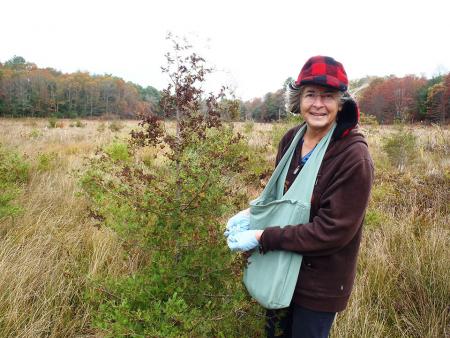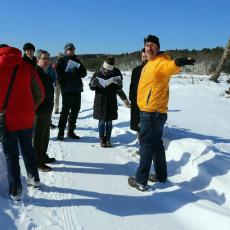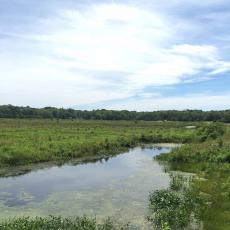In Our Spotlight
Tidmarsh Restoration Project & Living Observatory
Opportunities to return a large working farm back to a more natural state are very rare. But that is what is happening in the small seaside village of Manomet, not far from the site of the Pilgrims’ 1620 arrival in the town of Plymouth, Massachusetts. Defined by the Beaver Dam Brook Watershed, Manomet is home to Tidmarsh Farms’ magnificent 600 acres. As you read this, the property is already evolving back to a place of beauty and refuge to benefit animals, the environment (and people as well).
This extensive project involves retiring and restoring commercial cranberry bogs, thereby ensuring that the surrounding watershed will be protected from the impacts of pesticides, fertilizers and machines that were used to change and shape its landscape for decades of harvests of the area’s iconic berry. Returning Tidmarsh Farm to its original state will accomplish many missions: restoration of natural wetlands and streams, improving water quality, enhancing biologic diversity and creating a mosaic of habitats.
In parallel to the restoration, a new initiative, The Living Observatory (LO) is inviting scientists and designers to help tell the story of ecological changes as they occur on the site over time. (More on that effort later in this article.)
The impact of generous landowners
What would you do if you owned 600 acres in southeastern Massachusetts that included a cranberry bog with dams built in 1923, a river running through it and a large peat bog under two feet of sand? This was the question facing Evan Schulman, Glorianna Davenport and the three Schulman children. First, they made the decision to retire from the cranberry business, then, together, they all took a hard look at this sizable property. What they saw was water: lots and lots and lots of water. They wisely met with a slew of professionals and organizations, many of whom later developed into valued collaborators.
After weighing many options, they resolved to restore and heal the wetlands beginning with a conservation and restoration easement from the Natural Resources Conservation Services. Glorianna says that the family faced a steep learning curve, but feel fortunate to have been introduced to well-informed, caring people at the beginning of this journey.
One of these people was Alex Hackman, Restoration Specialist with the Division of Ecological Restoration at the Massachusetts Department of Fish and Game. Hackman’s advice was crystal clear: “Do an intervention and put the land on a solid course for ecological sustainability of this landscape. Remove stressors on the land, such as dams, ditches, berms and sand (where you can), and dig a new 3.5 miles stream channel to let the water flow naturally.”
Project Scope and Partners
A heady mix of stakeholders have come together to make this restoration possible. At the helm is Hackman: a man on a mission. He seems to have stepped out of central casting just for this role.
He has years of relevant experience under his belt to head up this project. Chief among them, the recent restoration of another cranberry bog in nearby Eel River. Although it was much smaller (40 acres), many of the same partners were involved which helped to set the stage for restoring Tidmarsh: the largest fresh water restoration ever undertaken in Massachusetts.
When asked what he is most excited about, Hackman quickly reels off three topics. “The first is the chance to work closely with this family and other great people on land conservation. It is not common to share a big vision for a large conservation effort with landowners who have the appetite and patience to walk through the complexities of this shared adventure,” he said. Hackman sees this opportunity as a real gift. Secondly, as an ecologist, he is excited by the opportunity to work at the unprecedented scale of a coastal aquatic habitat restoration: all the watershed flows through 250 acres of former bogs. The aim is to try to undo the agricultural effects on the land and to help it heal over time. Lastly, the specific mix of partners—local, state and federal—works in a truly collaborative way, each partner bringing their own expertise, all working towards a shared vision.
Hackman described the impacts of past farming and what they aim to rectify now. Any type of farming requires manipulation of land and water to produce crops. Prior to 1880s, this land was wetlands and swamp land. When the land became a cranberry farm, the landscape was manipulated dramatically to accommodate conditions needed for successful crops. Retiring the bogs from farming helps recharge nature, but on its own, does not restore the natural wetlands. In order for water flow to become normalized, physical barriers must be removed. Dams, dikes and berms that all hold water back, are being taken out. Next, there is the question of the sand that was needed for pest control and plant development. After 100 years of adding thin layers of sand approximately 2 feet of sand has accumulated . This thick layer covers the natural peat and raises the land surface above the water table making the land surface drier. The most effective and cost-efficient way to return natural wetland plants to the site is to saturate the sand with water by plugging irrigation ditches and elevating the ground water table. Finally, lots of logs, stumps and other woody debris exist on site. Hackman and his team will reconstruction channels of healthy water flow by reintroducing wood onto the property. He said, “Gigantic mountains of stumps will be put into the stream enhancing the habitat. Critters need these to hang out and hide from predators.”
A permanent nature sanctuary for passive recreation in the village of Manomet will be made available to residents and visitors. The Living Observatory, which will provide diverse learning and educational opportunities for people of all ages and interests, greatly extends the breadth of this project.
Living Observatory: Documenting and Experiencing Ecology
Blending technology with the landscape will provide a window on wetlands and wildlife normally invisible to humans. The use of low-powered sensors will capture variations in moisture, temperature and chemistry as well as sounds from the land. Video recordings will be streamed over the internet for observation, learning and enjoyment. This living laboratory will be a boon for those interested in the environment, geosciences, water ways and conservation practices.
Living Observatory is a project intended to document and interpret ecological changes to allow people, individually and collectively, to better understand the relationships between ecological processes, human lifestyle choices, and climate change adaptation.
Prior to her retirement in 2008, Glorianna Davenport spent many years working at the Massachusetts Institute of Technology’s world-renowned Media Lab. She is familiar with the use of sensor technology and maintains close working relationships with the Media Lab. This relationship has been integral to efforts to install a dense sensor network that monitors the wetland restoration process. This effort supports ongoing research in restoration ecology and explores how sensor data might extend human perception to change our relationship with the environment. “It is a whole new way of relating to environments,” says Davenport. “We have an opportunity to build a new medium with other types of sensor data, some of which we can see, feel hear and some of which is very invisible to us, but very meaningful to the future of the landscape.”
Living Observatory is a collaborative venture between scientists, engineers, artists, agencies, foundations, the local community, visitors and supporters from around the world. Key project partners include: Tidmarsh Farms; Living Observatory; Mass. Division of Ecological Restoration; USDA’s Natural Resources Conservation Service; US Fish and Wildlife Service’s Partners for Fish and Wildlife Restoration and National Coastal Wetlands Conservation Program; the National Oceanic and Atmospheric Administration’s Restoration Center; Town of Plymouth; Mass. Environmental Trust; Gulf of Maine Council on Marine Environment; American Rivers; Mass. Audubon Society; Salicicola; Manomet Center for Conservation Science; the Town of Plymouth and Manomet village; MIT; Boston University; UMass Amherst and UMass Boston; Rising Tide Charter School; Mass. Bays Program; local volunteers and more. For more information and a video, click on: https://www.youtube.com/watch?v=T8yZK_Pw32k.
UMass lends expertise
This multi-faceted project has created a perfect learning environment and the opportunity for the involvement of educational institutions, including the University of Massachusetts, MIT and Boston University. Hackman gives a shout out to the early work of David Boutt, associate professor in geosciences at UMass Amherst, along with graduate student Danielle Hare. According to Hackman, Boutt and Hare’s work was integral to understanding the subsurface of site and the hydrology of design so they could redirect channels and colder water to areas critical for cold-water fish to survive.
Christine Hatch, extension assistant professor in geosciences, continues to play an active role in the collaboration of researchers further enriching the culture of learning. She has taken students on site to analyze the interactions of surface and ground water. Hatch has also participated as part of team of people planting white cedar to stabilize the site with vegetation native to this area. 20,000 seeds from Atlantic white cedar trees have been collected and are growing for future planting which is projected to be 2016 and 2017. The goal is to establish only plants indigenous to southeastern Massachusetts.
Hatch adds, “As a researcher, it is so rare to have land owners who allow you on their property to make measurements of any kind. Here, not only do they allow us to be here, but they’ve invited any and all scientists to play in their “sandbox” with incredible generosity. As a researcher I’m thrilled to participate in this unprecedented scope and scale of collaboration between scientists from so many disciplines, and as an Extension faculty member, working with the MIT Media lab is an invaluable conduit for bringing science to the public. Glorianna and Evan’s vision for Living Observatory is an incredible gift to science, to educators and students of all ages, to their community and to the commonwealth.”
Hailing from UMass Boston’s Freshwater Ecology Laboratory (FEL), Professor Alan Christian and his students have studied this stream (Beaver Dam Brook) for several years, by investigating community and ecosystem structure and function. Professor Christian and his students have been studying macroinvertebrate and fish assemblages on a seasonal basis to look at the community structure through time. The FEL also is investigating how matter and energy flow through the system by looking at nutrient concentrations, nutrient limitation, and whole stream metabolism (oxygen and oxygen use). Overall, the FEL is interested how the stream community and ecosystem have changed over time has been a helpful piece of the complex puzzle.
According to Davenport, in the grand scheme of all this activity, UMass Amherst and Boston faculty and their students contribute to the knowledge of the restoration team and the story that will be shared with the public. The passion and scientific pursuits already underway are proving to be useful in planning the work of how and where to bring back healthy wetlands.
Future Visions and Plans
Glorianna and her team are extraordinarily thoughtful in their planning for the future of this site. She said, “Mass Audubon became a partner of Living Observatory in 2012. Since that time, Mass Audubon has been evaluating the opportunity to acquire the property as a future wildlife sanctuary where the public could gain first-hand experience as nature's heals itself across this restored landscape.” Randy Parker, a 40-year Manomet resident, recently said, “For Tidmarsh Farm owners to turn around and look with their children at this property a few years ago and decide to restore 250 acres of cranberry bog to wetlands is a feat that is just so benevolent and beneficial to this community.”






